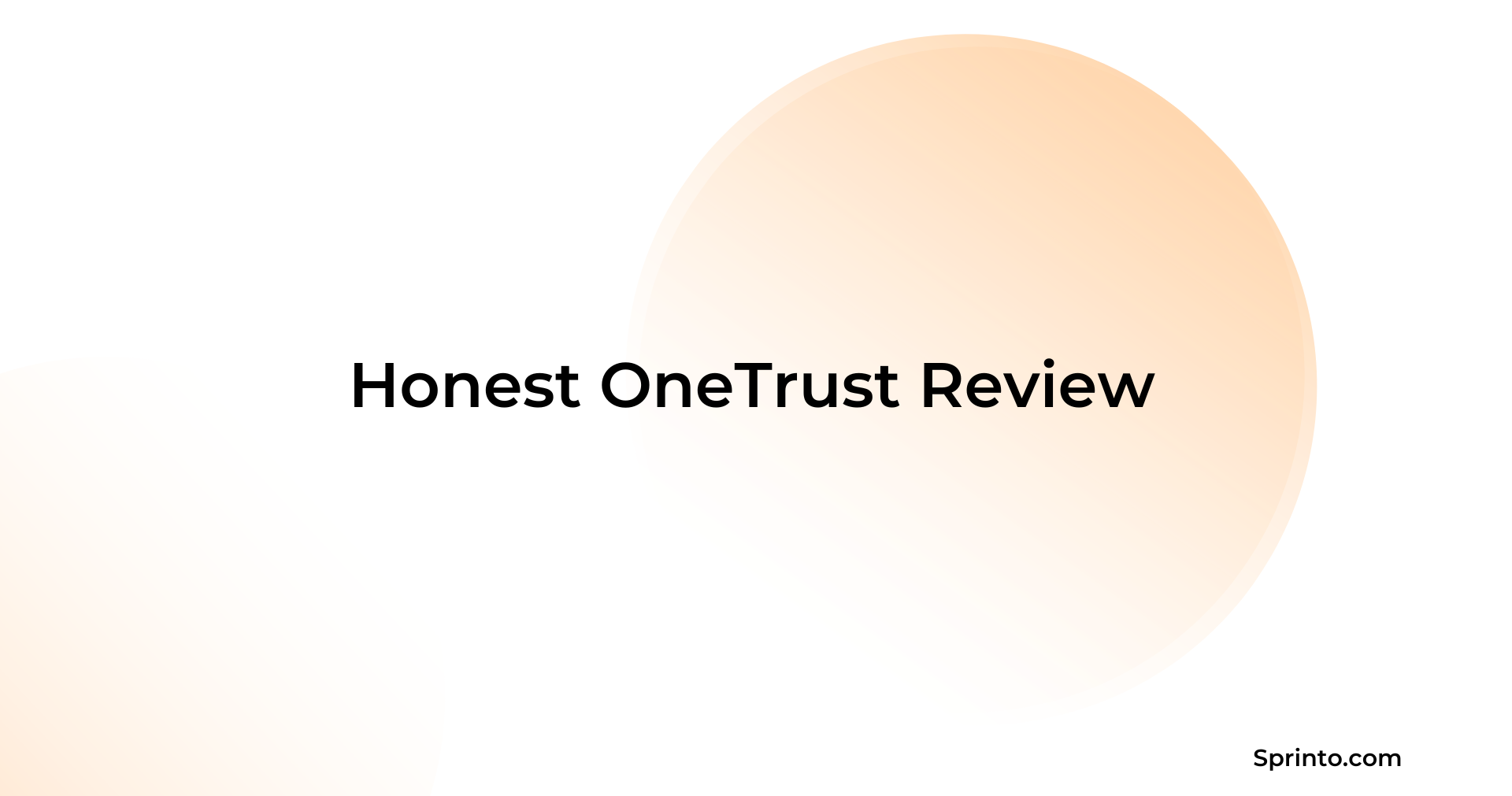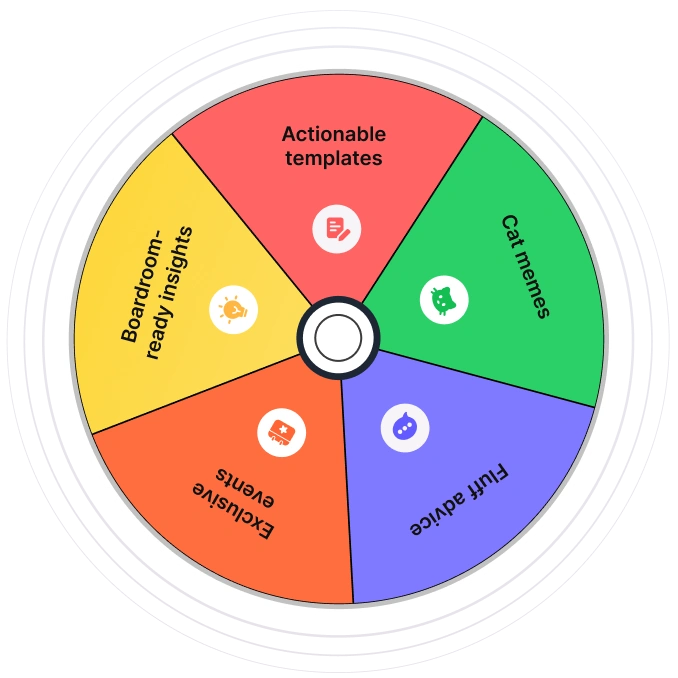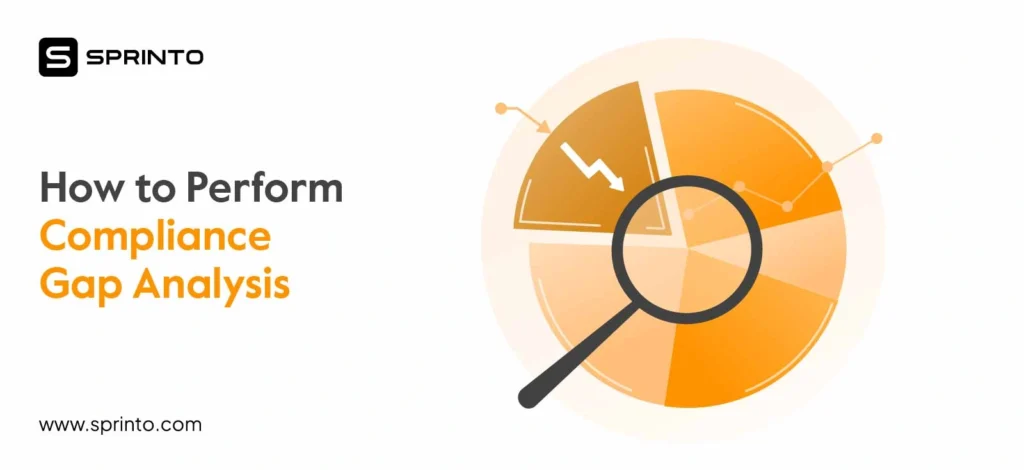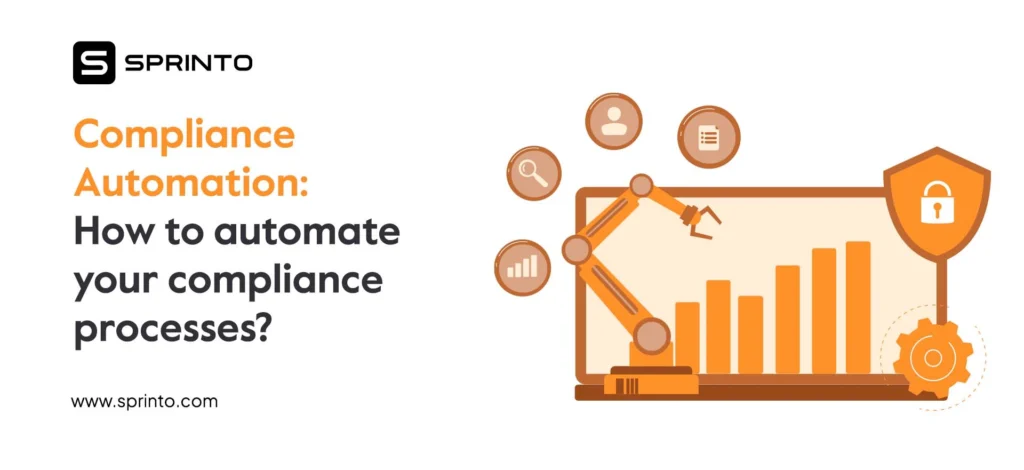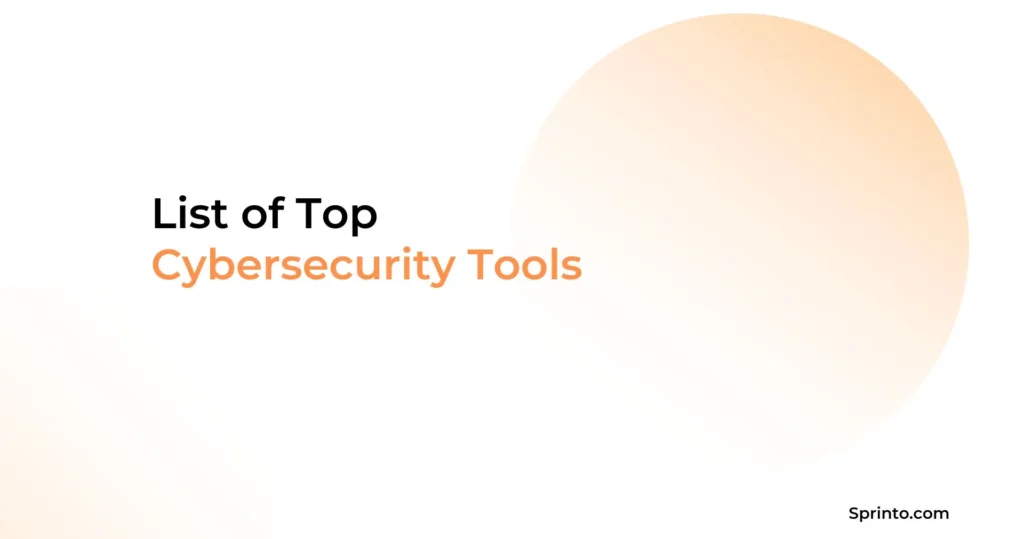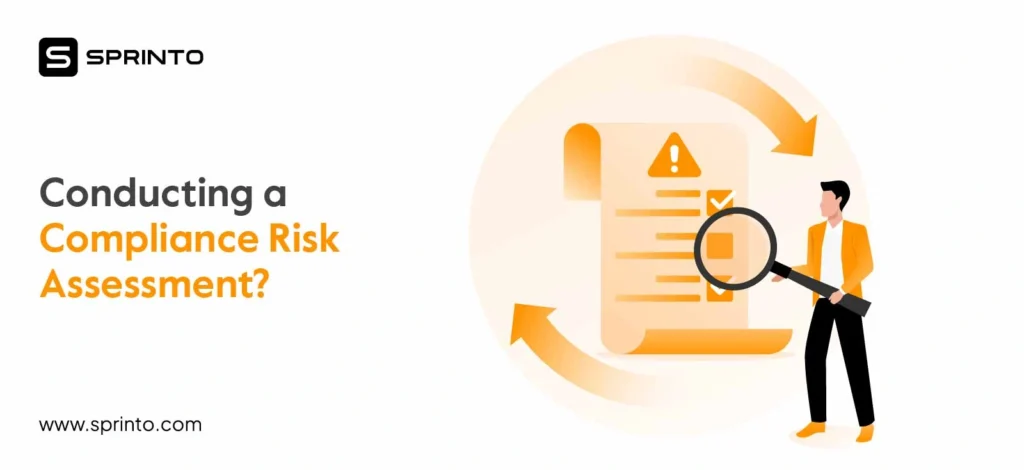For teams looking to solidify and scale their compliance programs, OneTrust has probably been discussed. It’s often seen as a safe and reliable option. OneTrust seeks to help organizations meet privacy compliance requirements and strengthen data protection through frameworks like GDPR and CCPA.
While it offers broad compliance coverage and automation capabilities, is the journey after signing the deal as smooth as claimed? Once teams go from evaluation to implementation, a typical pattern emerges. Setting it up can be complex and has a steep learning curve, which is especially undesirable for first-time users.
This OneTrust review will discuss where it excels, where it falters, and whether it’s the right solution for your needs.
| TL;DR: OneTrust offers broad compliance coverage, data privacy management, and automated workflows, but it’s not for everyone. Ideal for larger enterprises or teams with in-house GRC experts, the platform requires extensive onboarding time, setup, and customization. Many core features come with additional costs, and the current pricing model lacks transparency. |
Quick Overview
OneTrust is a GRC platform known for its compliance automation and TRPM features, with a strong focus on data security capabilities. Its strength lies in offering an all-in data solution that ensures compliance with an ever-evolving regulatory landscape.
It offers broad regulatory coverage, automation workflows, and consent management that help streamline privacy and risk management across processes.
But this doesn’t come without its own set of trade-offs— one of them being the complexity of the many moving parts, i.e., the policies and frameworks. Navigating this complexity is a time-consuming and, at times, counterproductive process.
Verdict: 7/10
OneTrust gets a 7/10 for its robust feature set and comprehensive compliance coverage. It’s built to support teams that actively handle sensitive data and must stay compliant with laws and regulatory frameworks like GDPR, CCPA, and more. For large enterprises with mature GRC processes, it offers strong regulatory coverage and privacy management capabilities.
When it comes to smaller teams, it’s often too complex out of the box. It can be fairly challenging to implement without a dedicated team experienced in data compliance or the technical know-how to handle complex systems. Besides that, the dashboard leaves room for improvement in clarity, customization, and overall user experience.
Key features
- OneTrust gives users control and transparency through effective consent and preference management.
- It helps you track how data flows, and lets you stay on top of incidents and privacy notices from a single platform.
- Using standardized workflows, you can automate the entire Data Subject Request (DSR) process, from intake to secure response.
- OneTrust helps you roll out AI responsibly through built-in tools for real-time risk visibility, reporting, and AI safety benchmarking.
- With automated workflows and integrations, it seeks to strengthen your compliance posture.
- It also simplifies risk management processes by automating risk assessment and control tracking, and offers visual risk analysis dashboards.
- Deeper insights into third-party issues and risks help teams build a risk-resilient third-party ecosystem.
Pros
- It makes it easier for global teams to handle data protection, privacy laws, and cookies/policies across different jurisdictions and regions.
- Covers 50+ global regulations, making it a go-to solution for teams navigating GDPR, CCPA, and other compliance frameworks.
- Strong automation reduces manual effort across vendor assessment, risk management, audits, and data management.
- Pre-built templates and regulatory guidance speed up standard compliance features.
Cons
- Initial setup can be complex and time-consuming, especially for small teams or users without GRC experience.
- With a wide range of policies and frameworks, the dashboard requires time to get used to.
- Reporting doesn’t fully capture the whole picture, and is limited in customization and depth.
- Support can be inconsistent and has been reported to be delayed at times.
- Has an enterprise-only fit with too much complexity for start-ups and teams looking for speed and simplicity.
- Jumping between different tools inside the platform creates a fragmented experience.
- Many key features come at an additional charge, making it more expensive as you scale.
OneTrust pricing
Previously, OneTrust pricing covered packages such as Consent and Preference Essentials, starting at $827/month and going up to $ 1,125/month for CCPA compliance and $2,275/month for GDPR compliance.
According to data from 321 transactions on Vendr, most OneTrust customers spend around $11,500 on the platform annually, with the pricing range falling between $1620 per year to as high as $42500 annually, for enterprise-level implementations.
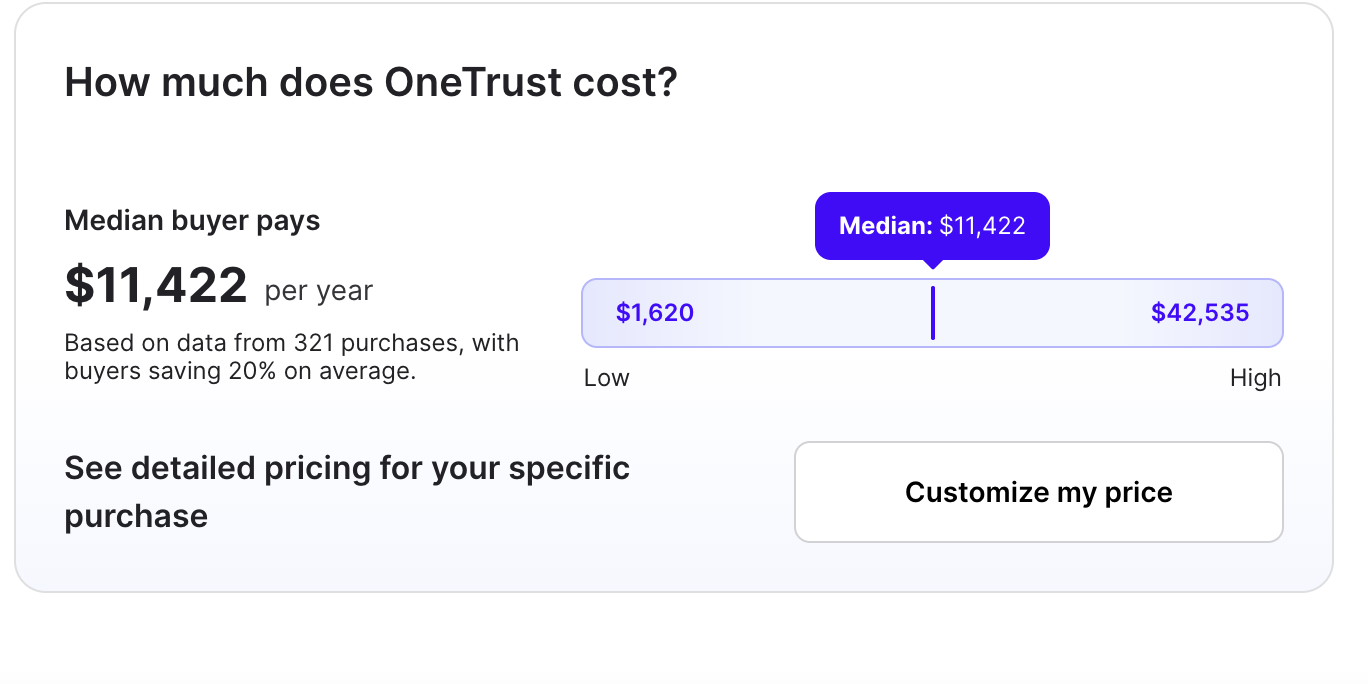
Source: https://www.vendr.com/marketplace/onetrust
Today, OneTrust follows a solutions-based pricing model to align with your compliance goals. Instead of a flat-rate plan, you can select a solution package that aligns with your use case.
Within each solution package are value-based usage meters that determine the pricing. The pricing is based on admin users and the inventory size being managed for privacy, tech, AI, or third-party programs or compliance programs.
For solutions associated with data use, the price is determined by the amount of data, the number of profiles, visitors, or data volume.
Verdict: 6.5/10
OneTrust follows a solutions-based pricing model, offering the flexibility to opt for solution packages tailored to your use case. Pricing is usage-based and tied to admin users, inventory size, and/or data usage.
While this approach works well from a scalability point of view, the absence of transparent pricing makes budgeting difficult for teams evaluating alternatives or estimating the total cost of ownership.
Get compliant faster with automation
OneTrust usability and interface
OneTrust’s interface has received mixed reviews from users. It is known to be feature-rich but not beginner-friendly.
Where it stands out:
- Automation and pre-built templates: It saves users from manual work and oversights that can expose them to threats and vulnerabilities.
- Customization features: The depth of customization across templates, consent experiences, and your brand makes it easier to mold the platform around internal processes.
- Pre-built regulatory infrastructure: With global coverage across 50+ regulations, OneTrust helps privacy and risk teams operate faster.
- Centralized oversight: Visibility into your data ops, compliance frameworks, and business scopes.
Where it lags:
- Not intuitive for first-time users: The main friction point is the steep learning curve. Most novice users struggle with implementation without hand-holding, especially without a GRC experience.
- Cumbersome UI and navigation: The interface has multiple ready-to-implement frameworks and policies, so it can take a while to figure out tasks like uploading assets and saving cookie settings.
- Limited dashboard and reporting capabilities: Users say the platform’s native reporting is too rigid. Even the dashboards lack the depth or flexibility needed to extract meaningful insights.
- Support can be hit or miss: Support can sometimes be slow or unresponsive, which can be a blocker during onboarding or when users face technical issues.
Verdict: 6.5/10
OneTrust’s rich functionality and global compliance coverage come at the cost of ease. While advanced teams can value their flexibility and automation, first-time users can expect a steep learning curve.
Zooming in on OneTrust’s Functionalities
OneTrust is known for its broad scope across privacy, security, regulation, and governance, positioning itself as a complete GRC platform. But how well does it fare at the feature level? Let’s find out.
- Consent and Preference Management
With this feature, OneTrust lets you capture, store, and manage user consent across websites, mobile apps, OTT apps, and TVs, ensuring complete customer transparency.
Verdict: 8/10
Designed to be scalable and meet global user consent requirements, but the first-time setup can be tricky.
- Third-Party Risk Management
Users can stay on top of vendor risks through automated intake screening and real-time visibility into evolving third-party risks and issues.
Verdict: 7.5/10
A reliable end-to-end tool, with room for improvement around areas such as the interface and role-based access controls (RBACs).
- AI Governance
Helps you use AI responsibly by incorporating compliance checks and controls across the AI lifecycle. It also offers comprehensive AI governance tools along with regulatory frameworks.
Verdict: 8/10
Serves as a solid foundation for companies wanting to invest in ethical and secure AI use.
- Compliance Automation
Automates compliance workflows across 50+ regulatory frameworks using pre-built templates, evidence collection, and control mapping.
Verdict: 7/10
Despite the broad compliance coverage and automation, the initial setup can be time-intensive. It does not fully deliver on the modularity it promises, with few users pointing out the lack of connectivity between modules.
- Tech Risk Management
Includes end-to-end IT risk management and mitigation. It helps organizations surface and quantify risks across systems, assets, and vendors. It maps interconnected risks and ensures teams stay on top of key risk indicators (KRIs) through comprehensive visual dashboards.
Verdict: 7.5/10
Great for complex setups with mature IT compliance teams. Too advanced for smaller teams.
- Regulations and Frameworks
OneTrust offers compliance solutions across 50+ global frameworks and regulations. It claims to offer consent management for GDPR, CCPA, and more.
Verdict: 7.5/10
Stands out for its breadth, but the interface feels cluttered, making it challenging to manage multiple frameworks, policies, and documents.
- Data Privacy Management
Users get a robust data management system powered by automation and backed by full visibility into data flows and privacy risks.
Verdict: 7.5/10
Comprehensive but requires onboarding and expertise for implementing efficiently.
- Integration Capabilities
OneTrust is built with an ecosystem of pre-built integrations with platforms and tools like Microsoft, Amazon API Gateway, and Adobe, to support compliance workflows.
Verdict: 7.5/10
While the Integration library is expansive, implementation isn’t always smooth. Setup can be slow and complex, especially for on-premise environments. Users also face challenges in enabling customization, which usually involves long TATs.
OneTrust Ratings on popular review sites
If you’re considering OneTrust for your GRC requirements, you should know what actual users think about the product. Here’s how OneTrust stacks up across major review platforms.
G2 rating: 4.4 / 5 based on 268 reviews
The broad belief points towards a comprehensive GRC platform that delivers on data privacy management and compliance needs. Where it does fall back is the initial ramp-up time, dissatisfaction with reporting features, and a clunky setup process, especially for leaner teams.
Gartner rating: 4.1/ 5 based on 100 reviews
Capterra rating: 4.2 / 5 based on 49 reviews
Users appreciate OneTrust’s ability to manage complex compliance requirements in privacy, risk, and third-party risk management. However, they frequently note that the platform is not exactly easy to use out of the box. It requires customization effort and ongoing support.
Trust Radius: 8.4/ 10 based on 44 reviews
Overall sentiment
OneTrust clearly earns points for its strong privacy, risk, data governance, and compliance automation capabilities. However, the platform isn’t plug-and-play— it demands effort, particularly in the setup and onboarding stage. It isn’t exactly for self-serve teams with limited GRC expertise. Many users find value once fully set up, but limitations in reporting and slow customization may also come in the way.
Sprinto: The Best OneTrust Alternative
From complex setups to disjointed experiences, OneTrust demands heavy lifting and ongoing support. Sprinto solves for speed, automation, and ease while delivering broad compliance coverage and automated workflows across compliance and risk management. Unlike OneTrust, Sprinto is scalable for SMBs and enterprises.
Where Sprinto wins the battle:
- Faster go-live: Sprinto slashes setup time by almost 80%, allowing you to implement GRC workflows without losing momentum.
- Support that doesn’t keep you waiting: Users rate Sprinto higher than OneTrust in terms of customer support speed and responsiveness. This is crucial for lean teams that can’t afford delays.
- Always-on control monitoring: It is built for audit readiness, with continuous control monitoring and time-bound alerts that help prevent risks from turning into issues.
- Roadmap agility: Sprinto’s product roadmap evolves fast and ships improvements regularly for a smoother user experience.
- Transparent pricing: There are no hidden fees for integrations, support, or reports when you’re using Sprinto.
- 300+ plug-and-play integrations: Sprinto supports 300+ integrations with HR, cloud, and code environments, too with zero engineering effort.
- Built-in automation: 99% of compliance checks auto-run in the background, including evidence collection and control monitoring.
- Centralized audit dashboard: Track evidence, audit preparation, and collaboration in one clean, centralized dashboard.
Read how Scylla hit GDPR compliance in 4 weeks and saw a 3X boost in sales using Sprinto.
If you’re a fast-moving team looking to move past complex GRC platforms with steep learning curves, Sprinto gets you compliant in weeks, not months, with automation baked in.
Get compliant faster with automation
Srikar Sai
Srikar Sai turns cybersecurity chaos into clarity. As a Senior Content Marketer at Sprinto, he cuts through the jargon to help people grasp why security matters and how to act on it. He’s particularly drawn to the intersection of tech and business. Outside of work, he does what most people do: a mix of the mundane and the occasionally exciting. Some days it’s trekking or exploring someplace new; some days it’s catching up on his favorite shows, tinkering with something random, or getting lost in whatever piques his curiosity.
Explore more
research & insights curated to help you earn a seat at the table.



